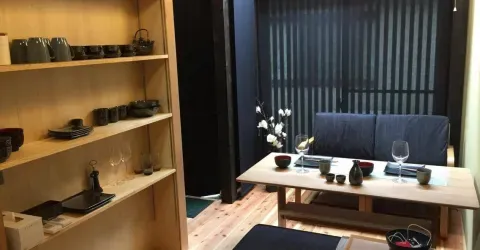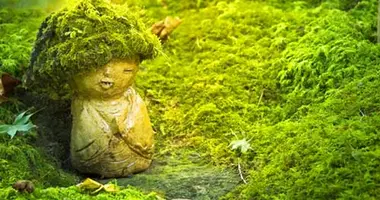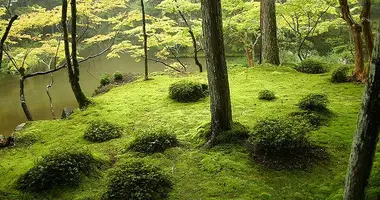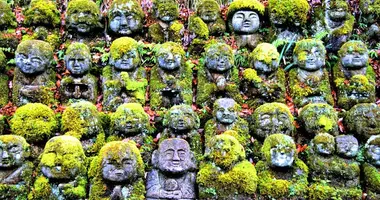Enryakuji Temple: A Monumental Buddhist Complex on Mount Hieizan

Stairs leading to Enryakuji Temple on the top of Mt Hiei in Shiga Prefecture
Perched atop Mount Hieizan, straddling the border between Kyoto and Shiga prefectures, stands the majestic Enryakuji Temple. This UNESCO World Heritage Site is not just a temple, but a vast monastic complex that has played a pivotal role in Japanese history and Buddhist traditions for over 1,200 years. As the headquarters of the Tendai sect of Japanese Buddhism, Enryakuji has been a cradle of Buddhist thought, nurturing some of Japan's most influential monks and shaping the country's spiritual landscape.
Founded in 788 by the revered monk Saicho, also known as Dengyo Daishi, Enryakuji Temple has withstood the test of time, overcoming destruction and rising from the ashes to continue its legacy. Today, it stands as a testament to the enduring spirit of Japanese Buddhism, offering visitors a unique blend of historical significance, architectural beauty, and spiritual tranquility.
Spread across three main areas - Todo (East Pagoda), Saito (West Pagoda), and Yokawa - Enryakuji invites visitors to explore its numerous halls, pagodas, and sacred spaces. From the awe-inspiring Konpon Chudo main hall to the serene forest paths connecting the temple's various sections, Enryakuji offers a journey through time and spirituality.
Whether you're a history enthusiast, a spiritual seeker, or simply a curious traveler, Enryakuji Temple promises an enriching experience that will leave you with a deeper appreciation of Japan's Buddhist heritage and the profound impact of this mountaintop sanctuary on the nation's cultural and religious fabric.
History and significance of Enryakuji Temple
The story of Enryakuji Temple begins in 788 CE when the monk Saicho, later known as Dengyo Daishi, established a small hermitage on Mt. Hiei. Inspired by his studies in China, Saicho sought to create a center for Tendai Buddhism in Japan. The temple's strategic location was no accident - it was believed to protect Kyoto from evil spirits approaching from the northeast, the direction associated with danger in Japanese geomancy.
Under imperial patronage, Enryakuji flourished, expanding into a vast complex of about 3,000 buildings at its peak. It became not just a religious center, but a powerhouse of learning and political influence. Many of Japan's most prominent Buddhist figures, including the founders of Jodo, Jodo Shinshu, Rinzai Zen, and Nichiren Buddhism, began their spiritual journeys at Enryakuji.
However, this power and influence came at a cost. The temple maintained a formidable army of warrior monks(sohei), which often clashed with rival temples and even the inhabitants of Kyoto. This militarization ultimately led to the temple's downfall in 1571 when the warlord Nobunaga Oda led a devastating attack, burning the complex to the ground and slaughtering its inhabitants.
Yet, like a phoenix rising from the ashes, Enryakuji was rebuilt after Nobunaga's death. The oldest existing buildings date from the late 16th and early 17th centuries, a testament to the temple's resilience and enduring significance. Today, Enryakuji stands not only as a place of worship but as a living museum of Japanese Buddhist history and architecture.

Enryakuji Temple
Layout and main areas of the temple complex
Enryakuji Temple is a vast complex spread across Mount Hieizan, covering an area of approximately 1,700 hectares. The temple is divided into three main areas, each with its own distinct character and important structures:
1. Todo (Eastern Pagoda) Area:
- This is the central and most visited area of Enryakuji.
- It houses the Konpon Chudo (Main Hall), the spiritual heart of the temple.
- Other significant structures include the Daiko-do (Great Lecture Hall) and the Kaidan-in (Ordination Hall).
- The Amida-do, built in 1937, is also located in this area.
2. Saito (Western Pagoda) Area:
- Located about a 20-minute walk from Todo, this area offers a more secluded atmosphere.
- The main structure here is the Shaka-do, the oldest building at Enryakuji.
- The Ninai-do, consisting of two connected halls, is another notable feature.
- The Jodo-in, set in a beautiful garden, serves as Saicho's mausoleum.
3. Yokawa Area:
- This is the most remote area, located about 4 kilometers north of Saito.
- The main building here is the Yokawa Chudo (Central Hall).
- Other structures include the Joko-in and the Ganzan Daishido.
These areas are connected by scenic forest paths, offering visitors a chance to experience the natural beauty of Mount Hieizan as they explore the temple complex. During peak seasons, a shuttle bus service operates between the areas, making it easier for visitors to see all parts of the temple.

The Eastern Pagoda Area, Enryakuji Temple

Ganzan Daishido, Enryakuji Temple
Key attractions and buildings within Enryakuji
Enryakuji Temple boasts a wealth of architectural and cultural treasures. Here are some of the key attractions visitors should not miss:
1. Konpon Chudo (Main Hall):
- The spiritual center of Enryakuji, believed to be built on the site of Saicho's original hut.
- Houses a statue of Yakushi Nyorai (Medicine Buddha) said to have been carved by Saicho himself.
- Features the "Eternal Dharma Light," a flame said to have been burning continuously for over 1,200 years.
2. Daiko-do (Great Lecture Hall):
- A place where monks receive training and engage in debates on Buddhism.
- Displays portraits of prominent monks associated with the Tendai sect.
3. Amida-do:
- Built in 1937, it houses an image of Amida Buddha.
- Features a beautiful suikinkutsu (water harp) near its entrance.
4. Shaka-do:
- The oldest building at Enryakuji, relocated from Mii-dera temple.
- Contains a standing image of the historic Buddha.
5. Ninai-do:
- Consists of two connected halls: Hokke-do (Lotus Hall) and Jogyo-do (Constant Practice Hall).
- Associated with the legend of the warrior monk Benkei, who supposedly lifted both halls on his shoulders.
6. Yokawa Chudo:
- The main hall of the Yokawa area, partially built on stilts due to the sloping terrain.
- Offers beautiful views, especially during autumn when surrounded by colorful foliage.
7. Ruri-do (Lapis Lazuli Hall):
- One of the few structures to survive Oda Nobunaga's attack in 1571.
- Located off the beaten path, offering a glimpse into the temple's long history.
These structures, along with the natural beauty of Mount Hieizan, create a unique and inspiring environment that reflects the long and rich history of Enryakuji Temple.

Kaidan-in, Enryakuji Temple, Shiga Prefecture
The temple's role in Japanese Buddhism and culture
Enryakuji Temple has played a pivotal role in shaping Japanese Buddhism and culture for over a millennium. As the headquarters of the Tendai sect, it has been at the forefront of Buddhist thought and practice in Japan:
1. Cradle of Japanese Buddhism:
- Enryakuji is often referred to as the "Mother Mountain of Japanese Buddhism."
- Many influential monks who later founded their own sects studied here, including Honen (Jodo-shu), Shinran (Jodo Shinshu), Eisai (Rinzai Zen), and Nichiren.
- This diversity of thought nurtured at Enryakuji contributed to the rich tapestry of Japanese Buddhism.
2. Center of Learning:
- The temple was a major center of Buddhist studies, philosophy, and the arts.
- It played a crucial role in preserving and transmitting knowledge during the Heian period (794-1185).
- The emphasis on study and debate at Enryakuji influenced the development of Japanese intellectual traditions.
3. Political Influence:
- At its peak, Enryakuji wielded significant political power, often intervening in imperial succession disputes.
- The temple's army of warrior monks (sohei) was a force to be reckoned with in medieval Japan.
4. Cultural Contributions:
- Enryakuji has been a source of inspiration for Japanese literature, art, and folklore.
- The temple's location on Mount Hiei has made it a symbol of spiritual retreat and ascetic practice.
5. Preservation of Traditions:
- Enryakuji continues to maintain traditional Buddhist practices, including the famous "marathon monks" who undertake a 1,000-day walking meditation.
- The temple plays a role in preserving ancient rituals and ceremonies.
6. Interfaith Dialogue:
- In recent years, Enryakuji has hosted interfaith meetings, promoting dialogue between different religions.
- This reflects the temple's ongoing role in addressing contemporary spiritual and social issues.
Enryakuji's influence extends far beyond its physical boundaries, making it a living monument to the enduring impact of Buddhism on Japanese culture and society.

Enryakuji Temple protects Kyoto from the evil emanating from the north east direction
Accessing Enryakuji Temple: Transportation options
Reaching Enryakuji Temple atop Mount Hiei requires some planning, but the journey is part of the experience. Here are the main transportation options:
1. From Kyoto:
- Take the Eizan Electric Railway from Demachiyanagi Station to Yase-Hieizanguchi Station (about 15 minutes).
- From there, take the Eizan Cable Car to the top station (about 7 minutes).
- Transfer to the Eizan Ropeway for the final ascent (about 5 minutes).
- From the ropeway station, it's a short walk or bus ride to the Todo area.
- Note: The Eizan Cable Car and Ropeway do not operate from early January to mid-March.
2. From Shiga (Lake Biwa side):
- Take the JR Kosei Line from Kyoto Station to Hieizan-Sakamoto Station (about 15 minutes).
- Walk or take a short bus ride to the lower station of the Sakamoto Cable Car.
- The cable car takes about 11 minutes to reach the top.
- From the upper station, it's a 5-10 minute walk to the Todo area.
- The Sakamoto Cable Car operates year-round.
3. Direct Bus:
- There are direct buses from Kyoto Station and Sanjo-Keihan Station to Enryakuji's Todo area.
- The journey takes about one hour.
- Note: These buses do not operate from December through mid-March.
4. By Car:
- A toll road leads to the temple complex, accessible from both Kyoto and Shiga sides.
- Parking is available near the temple.
5. Hiking:
- For the adventurous, hiking trails lead up to Enryakuji from various points, including from near Shugakuin Imperial Villa in Kyoto.
- These hikes can take 2-3 hours and offer beautiful views but require good physical condition.
Once at Enryakuji, shuttle buses operate between the Todo, Saito, and Yokawa areas from March to November. In winter, visitors need to walk between areas or limit their visit to the Todo area.
Click here for more detailed access information.
Seasonal highlights and views from Mount Hieizan
Enryakuji Temple and Mount Hieizan offer stunning vistas and unique experiences throughout the year. Each season brings its own charm:
1. Spring (March to May):
- Cherry blossoms bloom in late March to early April, creating a picturesque setting.
- The weather is mild, making it ideal for exploring the temple grounds and hiking.
- The fresh green leaves of the surrounding forest provide a vibrant backdrop.
2. Summer (June to August):
- While it can be hot and humid, the mountaintop location offers cooler temperatures than the cities below.
- The lush green forests are at their peak, offering a refreshing escape.
- Clear days provide panoramic views of Kyoto and Lake Biwa.
3. Autumn (September to November):
- The fall foliage is spectacular, with the maple trees turning brilliant shades of red and gold.
- Peak autumn colors usually occur in mid to late November.
- The crisp air and clear skies offer the best views of the year.
4. Winter (December to February):
- Snow often covers the mountain, creating a serene, otherworldly atmosphere.
- The sight of the temple buildings dusted with snow is particularly beautiful.
- Note that access can be limited during this season, and some areas may be closed.
Viewpoints and Attractions:
- The Todo area offers sweeping views of Kyoto city to the west.
- From the Sakamoto Cable Car, visitors can enjoy stunning vistas of Lake Biwa, Japan's largest freshwater lake.
- The path between Todo and Saito areas provides beautiful forest scenery.
- The Yokawa area, being the most remote, offers a sense of isolation and connection with nature.
Special Events:
- The Hiei-zan Himatsuri (Fire Festival) is held annually on April 21st, featuring a torch-lit procession.
- In August, the Yuki Shrine Festival includes traditional performances and rituals.
- The Daihiei-zan Kangakue in October is a major Buddhist ceremony.
Regardless of the season, Mount Hieizan offers visitors a chance to experience the harmony between nature and spirituality that has been cultivated at Enryakuji for over a millennium.

Temple gate at Enryakukji Temple
Visitor information and nearby attractions
To make the most of your visit to Enryakuji Temple, here's some essential information and suggestions for nearby attractions:
Visitor Information:
- Opening Hours:
- Todo area: 8:30 to 16:30 (March to November), 9:00 to 16:00 (December to February)
- Saito and Yokawa areas: Open 30 minutes later and close 30 minutes earlier than Todo
- Admission Fees: 1,000 yen for adults, 700 yen for high school students, 600 yen for children
- Guided Tours: Available in Japanese; audio guides in English can be rented
- Accessibility: Some areas may be challenging for visitors with mobility issues due to steps and uneven terrain
- Dining: There's a restaurant in the Enryakuji Kaikan serving shojin ryori (Buddhist vegetarian cuisine)
Tips for Visitors:
- Wear comfortable walking shoes as there's considerable walking involved
- Bring warm clothing, even in summer, as it can be cooler on the mountain
- Allow at least half a day to explore the main areas of the temple
- Consider staying overnight at the Enryakuji Kaikan for a more immersive experience
Nearby Attractions:
- Sekizanzen-in Temple: A beautiful temple at the foot of Mount Hiei
- Shugakuin Rikyu: An imperial villa with stunning gardens, located in northeast Kyoto
- Hiyoshi Taisha Shrine: An important Shinto shrine at the base of Mount Hiei
- Lake Biwa: Japan's largest freshwater lake, offering various recreational activities
- Kofukuji: If you're interested in temple history, this former rival of Enryakuji in Nara is worth a visit
Accommodation:
- For those wishing to stay near Enryakuji, options include:
- The Enryakuji Kaikan on the mountain itself
- Ryokans and hotels in nearby Sakamoto town
- Various accommodations in Kyoto city
Remember to check the official Enryakuji website for the most up-to-date information on opening hours, events, and any temporary closures.
Visiting Enryakuji Temple offers a unique opportunity to experience Japan's rich Buddhist heritage in a stunning natural setting. Whether you're interested in history, spirituality, architecture, or simply seeking a peaceful retreat, Enryakuji and its surroundings have something to offer every visitor.
Click here to view a map of Enryakuji and nearby attractions
For more information on temples and shrines in Japan, visit our guide to Japan Temples & Shrines. If you're planning to explore more of Kyoto, check out our comprehensive Kyoto guide.





























